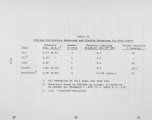| OCR Text |
Show to look at wood residue as an alternate fuel. The major problem to be dealt with in the burning of wood is the moisture content. Combustion and wood-handling technology is well developed, having made great strides in the ability to handle either wet wood or dry wood in raw form, or more developed forms such as pellets, wood gas and charcoal. The available heating value for green wood is appoxi-mately 3,000 to 4,000 BTU's per pound; however, more refined and moisture-free wood will supply as much as 8,500 to 10,000 BTU's per pound. For every ton of green wood or forest biomass used for energy, the BTU equivalent of one barrel of number 6 oil is not used. If refined biomass is used, the equivalent of three barrels of number 6 oil would not be used. Florida, with its long growing season and wide variety of commercial and non-commercial plant species, is in a strong and favorable condition to supply a significant volume of biomass for energy. 1.2 Economics of Wood as an Energy Source Compared to Other Fuels Florida's ability to supply forest biomass for energy is of significant importance. The state has approximately 16 million acres of commercial forest land capable of producing at least 2-1/2 tons of forest biomass per acre per year. Standing in Florida's forests today are soms 2.5 billion cubic feet of rough, rotten and cull trees which should be utilized in some manner so that their value will not be lost to the landowners and to the communities. Wood fuel as a source of energy offers an outstanding opportunity for such use. Add to this the vast volumes of waste generated from lumber and other forest produces, manufacturing, logging residue, harvest operations, wood destroyed in land clearing and urban development, and the hundreds of thousands of tons buried in landfills-the potential becomes substantial indeed. 26-3 |



























